Sustainability of Transport System of Large Russian City in the Period of COVID-19: Methods and Results of Assessment
Abstract
1. Introduction
2. Materials and Methods
2.1. Historical Digression-Dynamics of COVID-19 Development
2.2. Purpose, Problems, and Methods of Research
- The identification of a “sustainability” concept regarding the CPPT system and its functioning in the environment. Choosing the elasticity index as a sustainability characteristic.
- Mining and analyzing statistics on the changes of the parameters of CPPT system functioning in a large Russian city (on the example of Tyumen, with a population size equal to 807 thousand people) in emergency conditions (acute stage of COVID-19 pandemic).
- The development of an evaluation method and the calculation of the CPPT system sustainability indicator.
- Modeling a time series of changes in the elasticity index EL of the Tyumen CPPT system during the acute phase of the COVID-19 pandemic (30.03.2020–31.05.2020).
- The development of a CPPT system sustainability classification in a period of significant negative environmental impact.
- The final assessment of the Tyumen CPPT system management quality in the period of the acute phase of the COVID-19 pandemic.
2.3. Identification of a “Sustainability” Concept Regardingthe CPPT System and Elasticity as a Sustainability Characteristic
2.4. Data onthe Situation in the Transport Service Sphere of Tyumen in March–June 2020
3. Methods
3.1. Principal Approaches to the Evaluation of the City Transport System Sustainability in the Conditions of COVID-19
- -
- provide transport accessibility for the realization of the main activity types necessary for life support;
- -
- be financially acceptable for a wide segment of the population;
- -
- be safe and reliable.
3.2. Method of Evaluation and Indicator of the Sustainability of the City Passenger Public Transport in the Period of the COVID-19 Pandemic
3.3. Classification of Levels of Sustainability of the CPPT System in the Period of Significant Negative Environmental Impact
4. Results and Discussion
4.1. Results of the Evaluation of the CPPT System Sustainability in the Period of the COVID-19 Pandemic
4.2. Distribution of Data by Class
4.3. Contentment of Tyumen Population with the Transport Service Quality in the Period of “Self-Isolation”
4.4. Analysis of Results
- For 26 out of 63 days, the Tyumen CPPT system functioning process was highly sustainable (EL = [−2; 2]). For another 30 days, the level of CPPT system sustainability was on medium level (EL= ]−6; −2] and [2; 6[). Almost 90% of the time, transport operators successfully coped with balancing between demand and supply of transport service.
- Despite the conclusion about the high level of balance between the demand and supply of transport service, imbalance also took place. Classes EL = [0; 2] and EL = [2; 6[ took place more frequently than other classes. It means that transportation managers decreased the supply of transport service to a lesser degree than the demand for transportation itself decreased. The managerial decision was aimed at maintaining the quality of transport service at some expense of transportation effectiveness.
- On specific days, a sharp imbalance between the demand and supply of the transport service occurred. There were seven imbalanced days out of 63: 5.04.2020 (the announcement of a vacation week for all of the country’s population); 13.04.2020–15.04.2020 (a sharp increase of transport supply in the situation of demand for transport stagnation); 25.04.2020 (a weekend day with adverse weather conditions); 18.05.2020–19.05.2020 (no explanation of imbalance was found).
- It should be noted that transportation operators professionally and quickly coped with balancing the demand and supply in the conditions of the acute phase of COVID-19. It was not easy in light of the necessity of the operational modification of a whole work plan of transport services for the population of a large city with 807 thousand citizens. From the citizens’ side, there were no complaints addressed to transport operators during the whole period of the acute phase of COVID-19 (nine weeks of April–May 2020).
- Simultaneously, with the positive effects mentioned in paragraphs 1–4, we should note the negative situation of the growth of relative expenses for the execution of transportations in Tyumen in the period of the acute phase of the COVID-19 pandemic. In the period of 30.03.20–31.05.20, the financial expenses of transporters significantly increased. These could lead to the bankruptcy of transport companies. Nearly 135–150 million rubles were spent on the functioning of the Tyumen CPPT system during April–May 2020.
- It should be noted that at the moment (spring–summer 2020), Russian authorities are paying serious attention to increasing the sustainability of economic and sociopolitical processes. Such a position formed under the impact of past events in the post-soviet space. Today, in Russia, a lot of events are held to minimize the negative system impact of sudden negative events on society.
4.5. Discussion
5. Conclusions
- -
- provision of risk-sustainability to the whole city transport service system;
- -
- provision of effective transport supply in conditions of decreased demand;
- -
- support of the balance between the demand and supply of transport service.
Author Contributions
Funding
Acknowledgments
Conflicts of Interest
References
- Solodkij, A.; Gorev, A. System approach to elimination of traffic jams in large cities in Russia. World Appl. Sci. J. 2013, 23, 1112–1117. [Google Scholar] [CrossRef]
- Leonidova, E.G. Stimulating final consumption within the reduction of regional inequality. Econ. Soc. Chang. Facts Trends Forecast 2020, 13, 59–73. [Google Scholar] [CrossRef]
- Vuchic, V.R. Urban Public Transportation Systems and Technology; Prentice-Hall: Englewood Cliffs, NJ, USA, 1981. [Google Scholar]
- Vuchic, V.R. Transportation for Livable Cities. New Brunswick; CUPR, Rutgers University: Newark, NJ, USA, 1999. [Google Scholar]
- Vuchic, V.R. Transport systems and policies for sustainable cities. Therm. Sci. 2008, 12, 7–17. [Google Scholar]
- Miller, P. Sustainability and Public Transportation: Theory and Analysis; Department of Civil Engineering, University of Calgary: Calgary, AB, Canada, 2014. [Google Scholar]
- Ibarra-Rojas, O.J.; Delgado, F.; Giesen, R.; Muñoz, J.C. Planning, operation, and control of bus transport systems: A literature review. Transp. Res. Part B Methodical 2015, 77, 38–75. [Google Scholar] [CrossRef]
- Currie, G.; De Gruyter, C. Exploring links between the sustainability performance of urban public transport and land use in international cities. J. Transp. Land Use 2018, 11, 325–342. [Google Scholar] [CrossRef]
- Qian, Y.; Ding, L.; Wang, W.; Qiao, G. Green level and sustainability evaluation with bus enterprises. CICTP 2017: Transportation Reform and Change—Equity, Inclusiveness, Sharing, and Innovation 2018. In Proceedings of the 17th COTA International Conference of Transportation Professionals, Shanghai, China, 7–9 July 2017; pp. 3032–3041. [Google Scholar]
- Dinesh, M.; Geetam, T. Sustainable Transport Systems: Linkages between Environmental Issues, Public Transport, Non-Motorised. Econ. Political Wkly. 1999, 34, 1589–1596. [Google Scholar]
- Holmgren, J. A strategy for increased public transport usage—The effects of implementing a welfare maximizing policy. Res. Transp. Econ. 2014, 48, 221–226. [Google Scholar] [CrossRef]
- Holmgren, J. Meta-analysis of public transport demand. Transp. Res. Part A Policy Pract. 2007, 41, 1021–1035. [Google Scholar] [CrossRef]
- Abouhassan, M. Urban Transport System Analysis. Urban Transp. XXIII 2017, 176, 57–68. [Google Scholar] [CrossRef]
- Ganin, A.A.; Kitsak, M.; Marchese, D.; Keisler, J.M.; Seager, T.; Linkov, I. Resilience and efficiency in transportation networks. Sci. Adv. 2017, 3, 1701079. [Google Scholar] [CrossRef]
- Lucas, K. Transport and social exclusion: Where are we now? Transp. Policy 2012, 20, 105–113. [Google Scholar] [CrossRef]
- Lippi, G.; Plebani, M. Laboratory abnormalities in patients with COVID-2019 infection. Clin. Chem. Lab. Med. 2020, 3. [Google Scholar] [CrossRef] [PubMed]
- McKibbin, W.; Fernando, R. The First Economic Modelling of Coronavirus Scenarios is Grim for Australia, the World. The Conversation, 3 March 2020. 12.19 am GMT. Available online: https://theconversation.com/the-first-economic-modelling-of-coronavirus_scenarios-is-grim-for-australia-the-world-132759 (accessed on 10 April 2020).
- Benvenuto, D.; Giovanetti, M.; Vassallo, L.; Angeletti, S.; Ciccozzi, M. Application of the ARIMA model on the COVID-2019 epidemic dataset, Data in Brief. Preprint 2020. [Google Scholar] [CrossRef]
- Coronavirus Will Change the World Permanently. Here’s How. Politico Magazine. March 19, 2020. 07.30 pm GMT. Available online: https://www.politico.com/news/magazine/2020/03/19/coronavirus-effect-economy-life-society-analysis-covid-135579 (accessed on 15 April 2020).
- Musinov, E.A.; Ovsyannikova, O.V. Psychology of behavior of people in emergency situation. Colloquium-Journal 2019, 3, 5–8. Available online: file:///C:/Users/E8E5~1/AppData/Local/Temp/psychology-of-behavior-of-people-in-emergency-situations.pdf (accessed on 14 July 2020).
- Sustainable Lifestyles: Today’s Facts & Tomorrow’s Trends. Available online: https://www.sustainable-lifestyles.eu/publications/publications.html (accessed on 11 July 2020).
- O’Neill, D.W.; Fanning, A.L.; Lamb, W.F.; Steinberger, J.K. A good life for all within planetary boundaries. Nat. Sustain. 2018, 1, 88–95. [Google Scholar] [CrossRef]
- Randers, J.; Golüke, U.; Wenstøp, F.; Wenstøp, S. A user-friendly earth system model of low complexity: The ESCIMO system dynamics model of global warming towards 2100. Earth Syst. Dyn. 2016, 7, 831–850. [Google Scholar] [CrossRef]
- Taleb, N. The Black Swan: The Impact of the Highly Improbable; Random House Trade Paperback Edition Inc.: New York, NJ, USA, 2010; p. 472. [Google Scholar]
- Callahan, G. Nassim Nicholas Taleb: The black swan: The impact of the highly improbable. Rev. Austrian Econ. 2008, 21, 361–364. [Google Scholar] [CrossRef]
- Gerami, V.D.; Colic, A.V. Management of Transport Systems. Transport Logistics Support; Urait: Moscow, Russia, 2014; p. 510. (In Russian) [Google Scholar]
- Werbach, A. Strategy for Sustainability: A Business Manifesto; Harvard Business Press: Boston, MA, USA, 2009. [Google Scholar]
- Kazem, C.; Richard, L. Sustainable Competitive Advantage: Towards a Dynamic Resource-Based Strategy. Manag. Decision. 1999, 37, 45–50. [Google Scholar] [CrossRef]
- Christopher, M. Logistics and Supply Chain Management. Creating Value-Adding Networks, 3rd ed.; Financial Times/Prentice Hall: Horlow, UK, 2005. [Google Scholar]
- Aronsson, H.; Brodin, M.H. The environmental impact of changing logistics structures. Int. J. Logist. Manag. 2006, 17, 394–415. [Google Scholar] [CrossRef]
- Lotfabadi, P.; Alibaba, H.F.; Arfaei, A. Sustainability; as a combination of parametric patterns and bionic strategies. Renew. Sustain. Energy Rev. 2016, 57, 1337–1346. [Google Scholar] [CrossRef]
- Marshall, A. Principles of Economic Science; Progress: Moscow, Russia, 1993; Volume 1, p. 414. (In Russian) [Google Scholar]
- Tyumen City Transport. Tyumencitytrans. Official Site. Available online: https://tgt72.ru/ (accessed on 7 July 2020).
- Department of Road Infrastructure and Transport of Tyumen City Administration. Official Site. Available online: http://www.tyumen-city.ru/ekonomika/transport/ (accessed on 7 July 2020).
- Ryzkov, A.Y.; Zyuzin, P.V. Urban Public Transport Development in Russia: Trends and Reforms. 2016. Available online: https://wp.hse.ru/data/2016/12/06/1113069366/05URB2016.pdf (accessed on 18 July 2020).
- Kahn, M. Concepts, definitions, and key issues in sustainable development: The outlook for the future. In Proceedings of the 1995 International Sustainable Development Research Conference, Manchester, UK, 27–28 March 1995; Keynote Paper. pp. 2–13. [Google Scholar]
- Sturgess, H.A. The choice of class intervals. J. Am. Stat. Assoc. 1926, 21, 65–66. Available online: esalq.usp.br›departamentos…LCE0216/Sturges1926.pdf (accessed on 20 July 2020). [CrossRef]
- Heinhold, I.; Gaede, K.W. Ingeniur Statistic; Springler Verlag: München, Germany; Wien, Austria, 1964; p. 352. [Google Scholar]
- Ayvazyan, S.A.; Enyukov, I.S.; Meshalkin, L.D. Applied Statistics. Fundamentals of Modeling and Primary Data Processing; Finance and statistics: Moscow, Russia, 1983; p. 471. (In Russian) [Google Scholar]
- Eldijk, J.; Gil, J.; Kuska, N.; Patro, R. Missing links—Quantifying barrier effects of transport infrastructure on local accessibility. Transp. Res. Part D Transp. Environ. 2020, 85, 102410. [Google Scholar] [CrossRef]
- Gharehbaghi, K.; McManus, K.; Robson, K. Minimizing the environmental impacts of mega infrastructure projects: Australian public transport perspective. J. Eng. Des. Technol. 2019, 17, 736–747. [Google Scholar] [CrossRef]
- Kurth, M.; Kozlowskim, W.; Ganin, A.; Mersky, A.; Leung, B.; Dykes, J.; Kitsak, M.; Linkov, I. Lack of resilience in transportation networks: Economic implications. Transp. Res. Part D Transp. Environ. 2020, 86, 102419. [Google Scholar] [CrossRef]
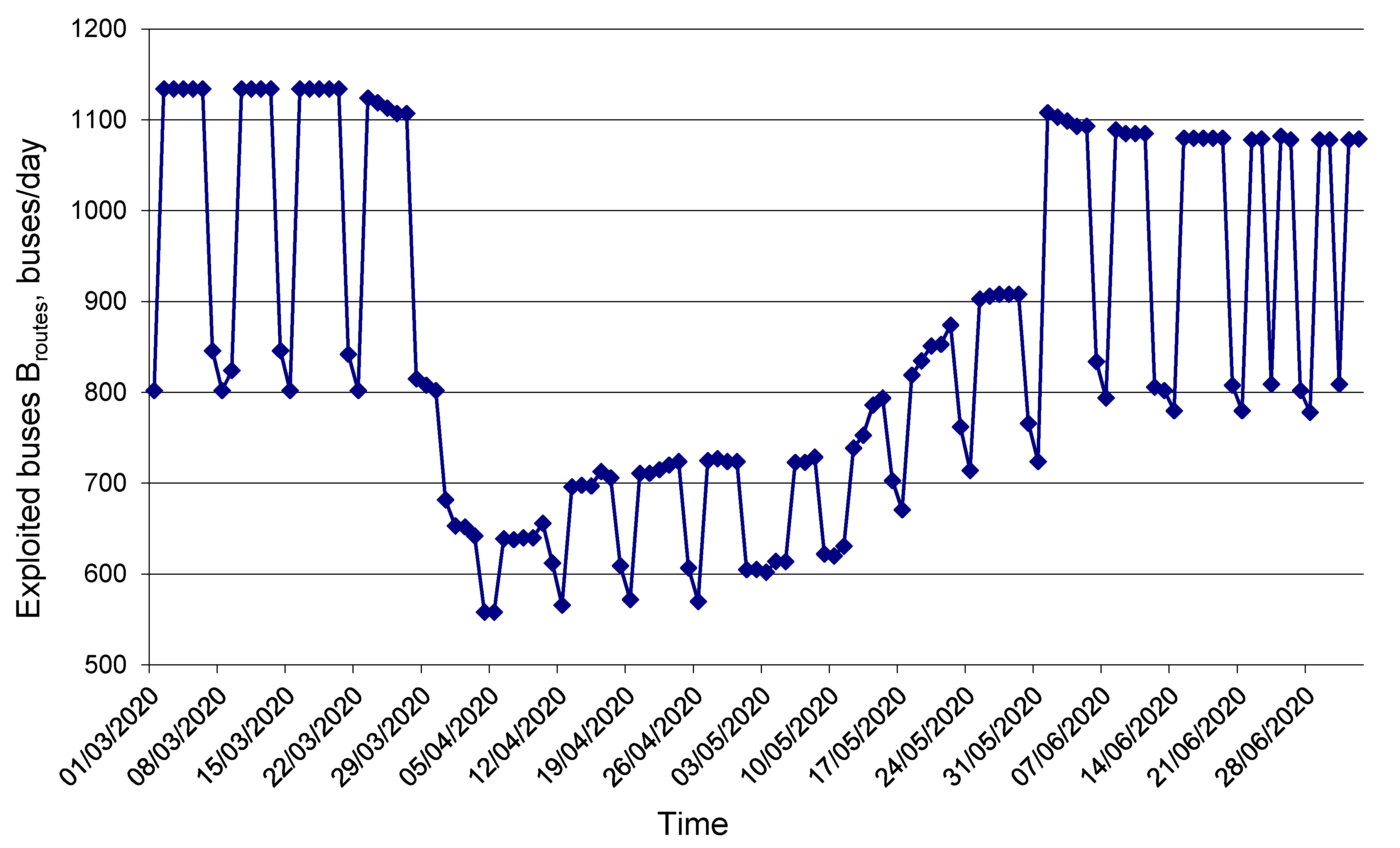
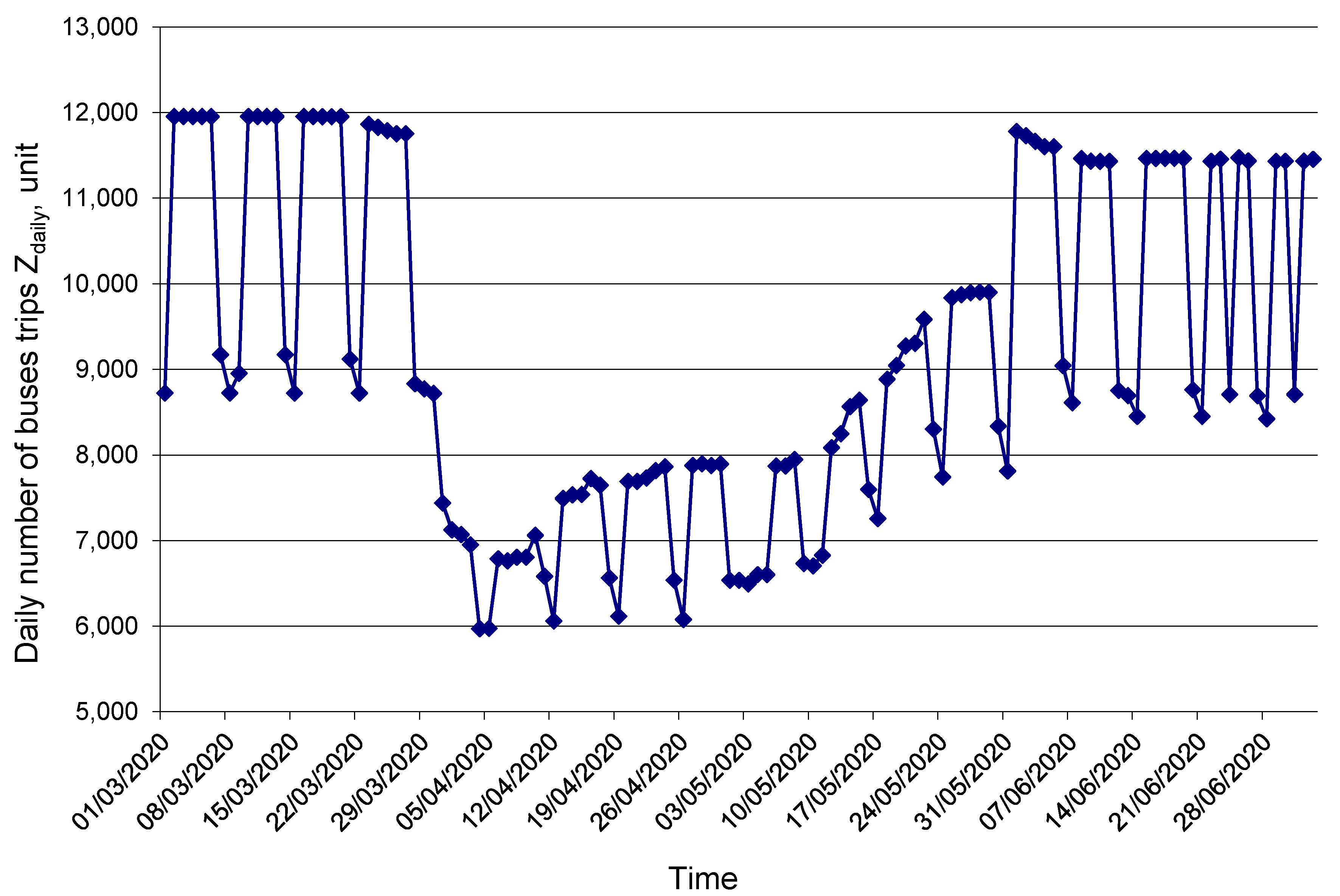
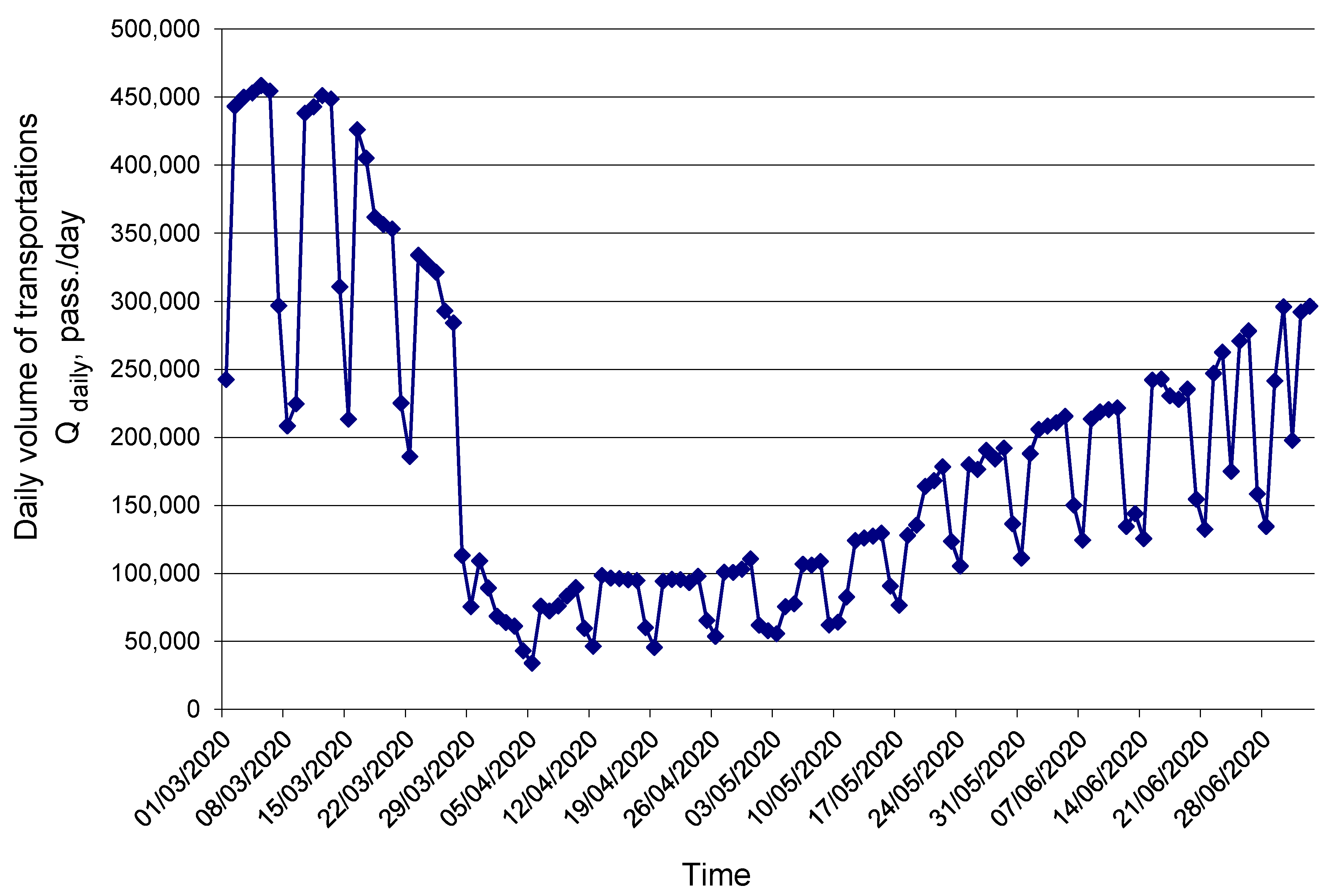
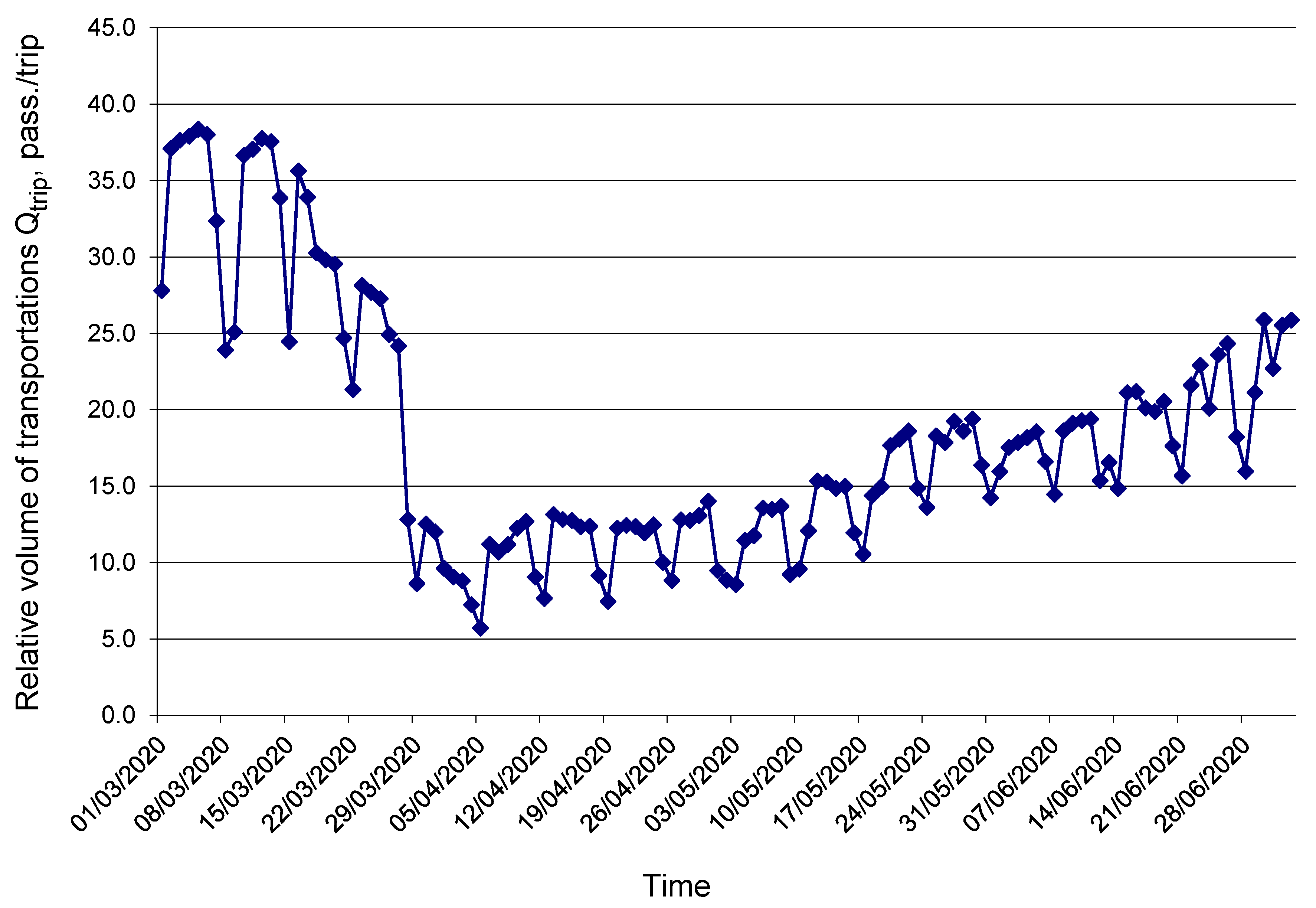
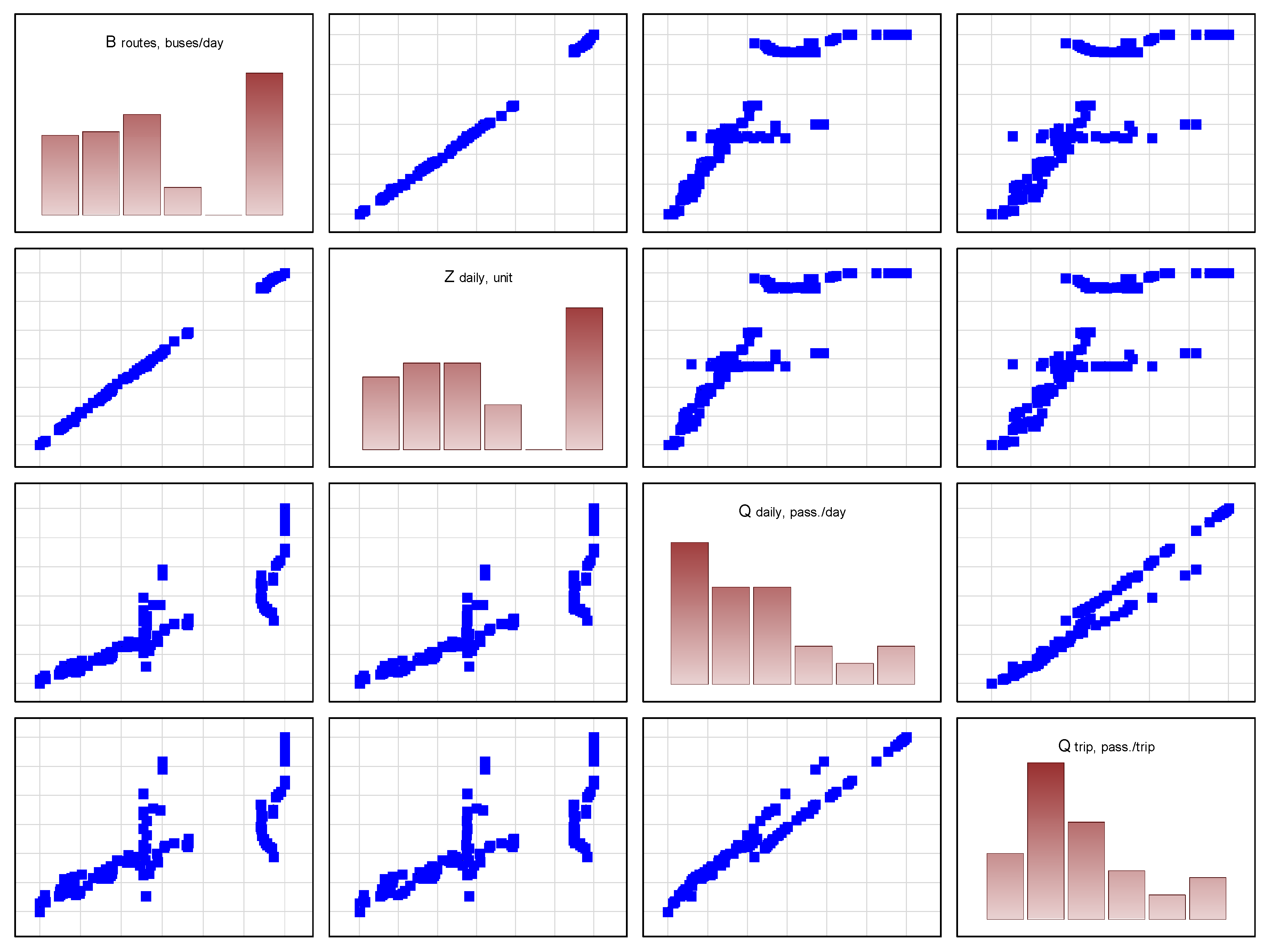
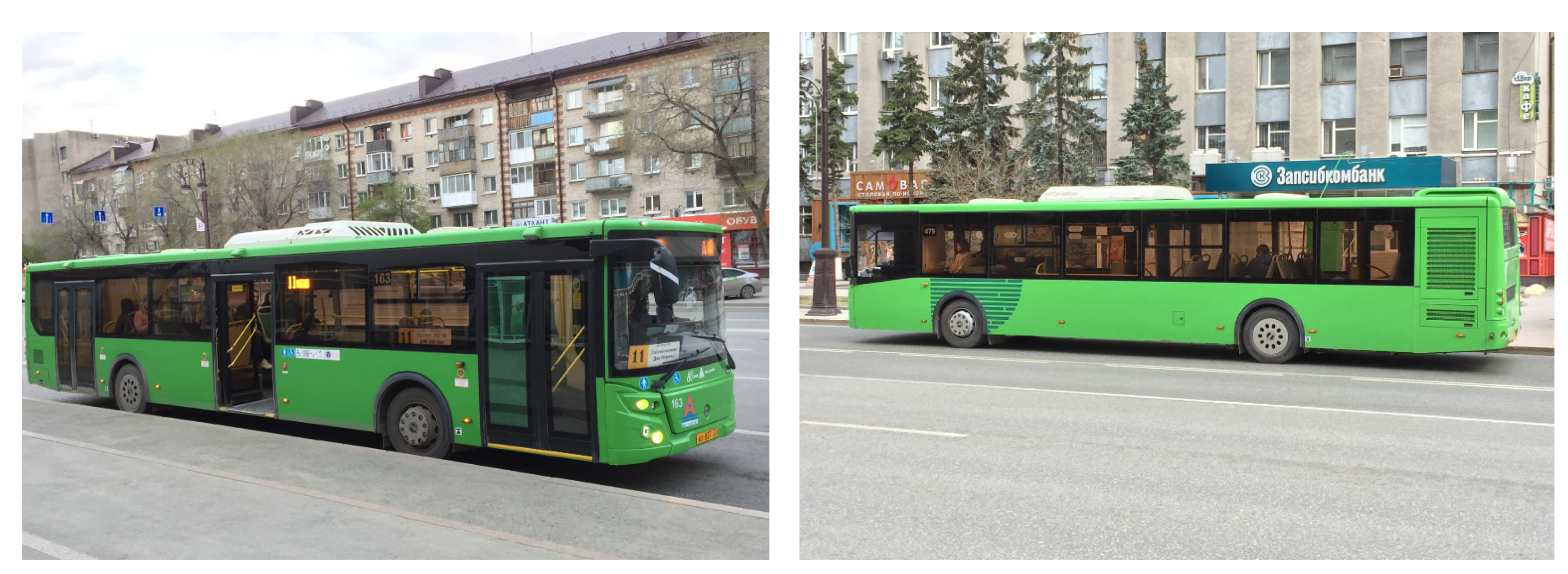

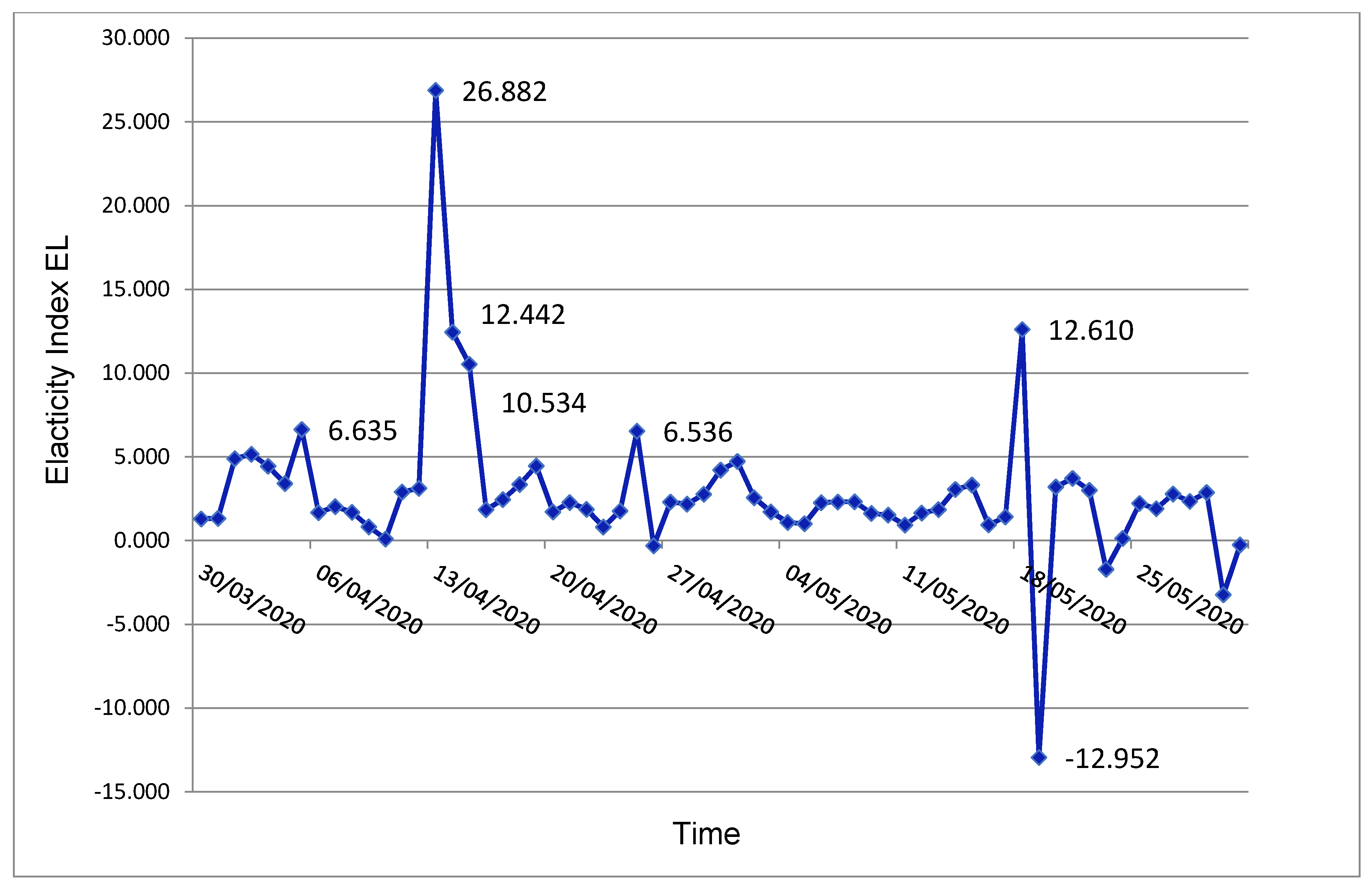
| X/Y | Y1-Broutes | Y2-Zdaily | Y3-Qdaily | Y4-Qtrip |
|---|---|---|---|---|
| X1-Broutes | - | 0.999 | 0.887 | 0.814 |
| X2-Zdaily | 0.999 | - | 0.882 | 0.813 |
| X3-Qdaily | 0.887 | 0.882 | - | 0.983 |
| X4-Qtrip | 0.814 | 0.813 | 0.983 | - |
| Day Type | Zaverage daily over the period, Number of Trips per Day | Qaverage daily over the period, Passengers per Day |
|---|---|---|
| Period 30.03.2020–3.05.2020 (5 weeks) | ||
| Weekday | 7492 | 90181 |
| Weekend | 6314 | 53092 |
| Period 4.05.2020–31.05.2020 (4 weeks) | ||
| Weekday | 8985 | 148589 |
| Weekend | 7320 | 91492 |
| Class | Class Name | Values of EL | CPPT System State |
|---|---|---|---|
| 1 | Very low level of system sustainability 1 | ]−∞; −10] | The demand for the CPPT service changed to become less than the transport service supply |
| 2 | Low level of system sustainability 1 | ]−10; −6] | |
| 3 | Medium level of system sustainability 1 | ]−6; −2] | |
| 4 | High level of system sustainability | [−2; 2] | Changes in the demand for the CPPT service and the transport service supply are balanced |
| 5 | Medium level of system sustainability 2 | [2; 6[ | The demand for the CPPT service changed to become more than the transport service supply |
| 6 | Low level of system sustainability 2 | [6;10[ | |
| 7 | Very low level of system sustainability 2 | [10; +∞[ |
| Class | Class Name | Values of EL | Number of Days in Current State |
|---|---|---|---|
| 1 | Very low level of system sustainability 1 | ]−∞; −10] | 1 |
| 2 | Low level of system sustainability 1 | ]−10; −6] | 0 |
| 3 | Medium level of system sustainability 1 | ]−6; −2] | 1 |
| 4 | High level of system sustainability | [−2; 2] | 26 |
| 5 | Medium level of system sustainability 2 | [2; 6[ | 29 |
| 6 | Low level of system sustainability 2 | [6;10 [ | 2 |
| 7 | Very low level of system sustainability 2 | [10; +∞[ | 4 |
| Respondents’ Gender | Respondents’ Age Groups | ||||
|---|---|---|---|---|---|
| 18–25 | 26–40 | 41–50 | 51–60 | 61–64 | |
| Male | 86/65 | 154/118 | 132/110 | 122/100 | 44/37 |
| Female | 62/50 | 426/364 | 441/381 | 87/73 | 28/19 |
© 2020 by the authors. Licensee MDPI, Basel, Switzerland. This article is an open access article distributed under the terms and conditions of the Creative Commons Attribution (CC BY) license (http://creativecommons.org/licenses/by/4.0/).
Share and Cite
Petrov, A.I.; Petrova, D.A. Sustainability of Transport System of Large Russian City in the Period of COVID-19: Methods and Results of Assessment. Sustainability 2020, 12, 7644. https://doi.org/10.3390/su12187644
Petrov AI, Petrova DA. Sustainability of Transport System of Large Russian City in the Period of COVID-19: Methods and Results of Assessment. Sustainability. 2020; 12(18):7644. https://doi.org/10.3390/su12187644
Chicago/Turabian StylePetrov, Artur I., and Daria A. Petrova. 2020. "Sustainability of Transport System of Large Russian City in the Period of COVID-19: Methods and Results of Assessment" Sustainability 12, no. 18: 7644. https://doi.org/10.3390/su12187644
APA StylePetrov, A. I., & Petrova, D. A. (2020). Sustainability of Transport System of Large Russian City in the Period of COVID-19: Methods and Results of Assessment. Sustainability, 12(18), 7644. https://doi.org/10.3390/su12187644






